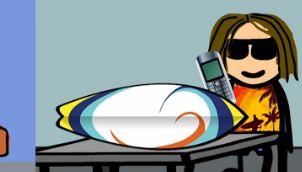Organizational Design and Structure - Answers
The answers are in BOLD below.
NOTE: The transcript from the video is listed below the quiz for your reference.
1. Organizational design involves:
- integrating people, technology and rules
- integrating people, technology and information
- integrating people, technology and policies
- integrating technology and rules only
- integrating people and rules only
2. Organizational structure involves:
- informal lines of power only
- formal lines of power and authority only
- formal lines of power, authority and roles
- informal lines of power, authority and roles
- processes for building the organization
3. What makes up an organization's environment?
- competition
- sociocultural
- political
- economic
- all choices are correct
4. If a manager changes from a manual system of production to the use of machinery, he is making a change in:
- sales
- manufacturing
- production
- technology
-
employee security
5. A strategy is a(n):
- action plan
- a policy
- a system
- a command
- a directive
There is a relationship between organizational design and structure because of different factors. Organization size, organizational life-cycle, strategy, environment and technology work together to form a complete organization.
The Relationship Between Organizational Design and Structure
Have you ever tried to build a house of cards? In order for it to remain standing, it is important that a strong base is built. The relationship between organizational design and structure works the same way.
When a new venture considers the design of its organization, it thinks far beyond the color of the office walls or wood tone for the desks. Organizational design is actually a formal process of integrating people, information and technology together in the right mix to achieve objectives. These are management choices that form an organizational culture. Organizational structure is the formal lines of authority and power, as well as the roles employees assume.
 |
The sales manager, Danno, promotes Kahuna surfboards all over the world. As he learns more about the surfers' needs, he communicates those needs to the production manager, Paolo, so they can get to work on making changes to design and function. The way the communication is done is through technology. Danno and Paulo connect several times a day via video chat and messaging. As Danno meets with clients, he sends a text. At the end of the day, they debrief during their chat sessions.
Any changes to design or function are then put into action the next day. Both Danno and Paolo have the authority to make important decisions on the spot. They are also held responsible for monitoring the outcome of changes in sales because of the changes.
 |
Because the structure is based on autonomy with a few hierarchal tiers, Big Waves is also a pretty relaxed place to work. Of the 12 employees, 11 are avid surfers, so catching a wave during lunch is very common. But when it comes time to build and sell surfboards, there is no hanging ten. They are all business.
The relationship between design and structure is demonstrated in the balance between production and employee relations. The formal process of design is evident in the relationship between Danno and Paulo as they work together to design perfect surfboards. There is a formal line of authority as well. Danno and Paulo decide on changes and assume the management role when delegating changes to surfboard makers. Top management gives plenty of latitude in decision-making, but the employees remain accountable for the design decisions.
Factors That Affect the Relationship Between Design and Structure
There are several factors that affect the relationship between organizational design and structure:
- Organization size
- Organization life cycle
- Strategy
- Environment
- Technology
Organizational size is a factor. A large organization has more employees and tends to have multiple levels of formal authority. By design, employees have less input in decision-making. There is also less social interaction between employees in a large company.
 |
Organizational life cycle refers to one of five stages of an organization's life, including introduction, growth, maturity, decline and death, and each stage affects the organizational design and culture. A company in its birth stage will have people and technology in place but it will not be as sophisticated as a company in maturity. A mature company is generally running smoothly, with little change to systems needed.
Big Waves is fairly new. They have systems in place, but as they grow and expand, it will be necessary for them to make changes. It may not be feasible for a sales manager and a production manager to text message and video chat. As more orders are placed for surfboards, it may be difficult to simply change a design or function on the fly. A new system of decision-making will have to be developed to accommodate mass production. In turn, this may change the relaxed culture. This may also end lunchtime surfing.
Strategy involves the actions performed to meet organizational goals. The larger the organization, the more likely it is that strategies are in place and employees are comfortable with the status quo. Strategies for design and production are not totally in place at Big Waves. In order to remain competitive, they need to be innovative with not only their product but their action plans.
 |
Surfboards are a relatively differentiated product with a small target market. There are few companies who manufacture boards. But Big Waves is not immune to changes in the environment. A change in safety codes may mean a stricter set of standards, making design changes almost impossible. This can affect customer satisfaction.
Technology involves things like computer systems and communication systems used to facilitate operations. For Big Waves, surfboards are hand-crafted and customers are used to waiting weeks for their delivery. As Danno takes more orders, Paolo must keep up with production. Technological changes could mean more employees are needed to do the work. With a larger staff, it may be necessary to incorporate a few hierarchal tiers, changing the power structure within departments. While this is a good thing for the overall organization, it could mean a disgruntled staff.
 |
Lesson Summary
There is a relationship between organizational design and structure because of different factors. Organizational design is actually a formal process of integrating people, information and technology. Organizational structure is the formal authority, power and roles in an organization. Organization size, organizational life cycle, strategy, environment and technology work together to form a complete organization.
As an organization grows in response to competition, its size impacts the type of and systems for authority in decision-making. An organization's stage in its life cycle affects the systems needed to produce product. A newer company may not have the needed technology to remain competitive, while an older company may be so set in their ways that they do not see a need for change.
New strategies can affect culture because employees may be very comfortable with the status quo. There may be a resistance to innovation that could affect the organization's competitive edge. Environmental factors like changes in safety requirements may cause products to be designed differently. Customers may not like the new features, causing sales to drop. New technology may require a larger staff, thereby changing the levels of hierarchy. Managers must consider these factors as they design the organization.